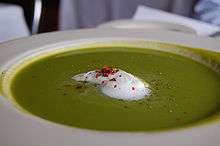Crème fraîche


Crème fraîche (English pronunciation : /ˌkrɛmˈfrɛʃ/, French pronunciation: [kʁɛm fʁɛːʃ], lit. "fresh cream") is a soured cream containing 10–45% butterfat and having a pH of around 4.5.[1] It is soured with bacterial culture, but is less sour than U.S.-style sour cream, and has a lower viscosity and a higher fat content. European labeling regulation disallows any ingredients other than cream and bacterial culture.
The name "crème fraîche" is French, but similar soured creams are found in much of northern Europe.
Terminology
In French-speaking countries, crème fraîche may refer to either the thick fermented product, crème fraîche épaisse or fermentée, or to liquid cream, crème fraîche liquide or fleurette. In these countries, crème fraîche without qualification normally refers to liquid cream, with the thick form usually called crème épaisse. In other countries, however, crème fraîche without qualification usually refers to the thick, fermented product.[2][3]
Production
Crème fraîche is produced by adding a starter culture to heavy cream, and allowing it to stand at appropriate temperature until thick.[3][2] The culture is made up of a mix of bacteria including Lactococcus species L. cremoris, L. lactis, and L. lactis biovar diacetylactis. This is what gives it the taste that distinguishes it from similar dairy products like sour cream.[4]
In some places in Europe, the fat content of crème fraîche is regulated, and it may not contain ingredients other than cream and starter culture.[1] In North America and the UK, products labeled "low-fat crème fraîche", with about 15% butterfat and with added stabilizers such as xanthan gum or maize/corn starch[5] are commercialized. It is less stable when heated.[3]
History

The crème fraîche from Normandy is famous, and the crème fraîche from a defined area around the town of Isigny-sur-Mer in the Calvados department of Normandy is highly regarded. It is the only cream to have an appellation d'origine contrôlée (AOC), which was awarded in 1986.[6] It is also produced in many other parts of France, with large quantities coming from the major dairy regions of Brittany, Poitou-Charente, Lorraine and Champagne-Ardenne.
Uses
Crème fraîche is used both hot and cold in French cuisine. It is often used to finish hot savory sauces; with its fat content greater than 30%, curdling is not a problem.[1] It is also the basis of many desserts and dessert sauces.
Similar products
Crema Mexicana is a somewhat similar cultured sour cream. Smetana from Eastern Europe and Russia is very similar.
See also
References
- 1 2 3 Meunier-Goddik, L. (2004). "Sour Cream and Creme Fraiche". Handbook of Food and Beverage Fermentation Technology. CRC Press. doi:10.1201/9780203913550.ch8. ISBN 978-0-8247-4780-0., p. 181f
- 1 2 McGee, p. 49
- 1 2 3 Goddik, p. 179-6
- ↑ Wingerd, S. (2011). A Fraîche Perspective - Crème Fraîche. http://culinaryalchemist.blogspot.no/2011/07/fraiche-perspective-creme-fraiche.html
- ↑ "Weight Watchers Creme Fraiche". Retrieved 27 October 2014.
- ↑ La crème AOC Isigny, 'Saveurs du Monde', http://www.saveursdumonde.net/articles/3399/
Further reading
| Wikimedia Commons has media related to Crème fraîche. |
- Harold McGee On Food and Cooking: The Science and Lore of The Kitchen (p. 49). New York: Scribner, 2004. ISBN 0-684-80001-2
- Lisbeth Meunier Goddik, "Sour Cream and Crème Fraîche" in Y. Hui Handbook of Food Science, Technology and Engineering (p. 179-6 to 179-7). Boca Raton, FL: CRC Press, 2006. ISBN 0-8493-9849-5.